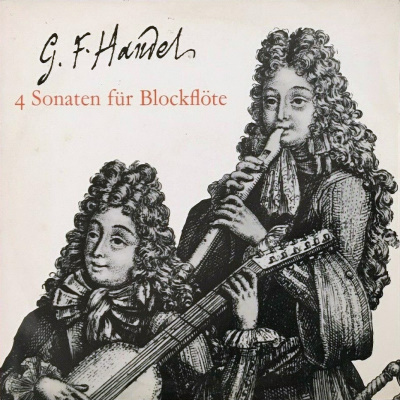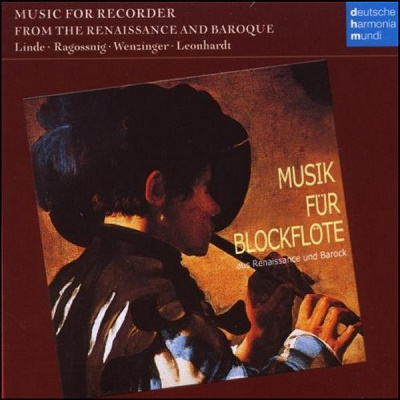 |
|
1 LP -
HM 30 617 - (p) 1962
|
 |
| 2 CDs -
82876 70032 2 - (c) 2005 |
|
4 SONATAS FOR
RECORDER
|
|
|
|
|
|
|
|
| Georg Friedrich
HÄNDEL (1685-1759) |
Sonata
for recorder in G minor, Op. 1, Nr.
2
|
|
8' 41" |
|
|
-
Larghetto
|
2' 13" |
|
A1 |
|
- Andante
|
3' 34" |
|
A2
|
|
-
Adagio
|
0' 48" |
|
A3 |
|
- Presto |
2' 06" |
|
A4 |
|
Sonata for
recorder in C major, Op. 1, Nr. 7 |
|
11' 27" |
|
|
-
Larghetto
|
2' 46" |
|
A5 |
|
-
Allegro |
2' 24" |
|
A6 |
|
-
Larghetto |
2' 07" |
|
A7 |
|
-
A tempo di Gavotta
|
1' 30" |
|
A8 |
|
-
Allegro |
2' 40" |
|
A9 |
|
Sonata for
recorder in A minor, Op. 1, Nr. 4 |
|
11' 25" |
|
|
-
Larghetto
|
2' 44" |
|
B1 |
|
-
Allegro
|
3' 05" |
|
B2 |
|
-
Adagio
|
1' 54" |
|
B3 |
|
-
Allegro
|
3' 42" |
|
B4 |
|
Sonata for
recorder in F major, Op. 1, Nr. 11 |
|
7' 38" |
|
|
-
Larghetto
|
2' 09" |
|
B5 |
|
-
Allegro
|
2' 15" |
|
B6 |
|
-
Siciliana
|
1' 09" |
|
B7 |
|
-
Allegro
|
2' 05" |
|
B8 |
|
|
|
|
|
| Hans-Martin
Linde, Recorder |
|
| August Wenzinger,
Viola da gamba |
|
| Gustav Leonhardt,
Harpsichord |
|
|
|
|
|
Luogo
e data di registrazione |
|
Remscheid (Germany) -
dicembre 1961 |
|
|
Registrazione: live
/ studio |
|
studio |
|
|
Recording
Supervision |
|
Dr. Alfred Krings
|
|
|
Prima Edizione LP |
|
Harmonia Mundi | HM
30 617 | 1 LP - durata 39' 18" |
(p) 1962
|
|
|
Edizione CD |
|
Deutsche Harmonia
Mundi | LC 00761 | 82876 70032 2 |
2 CDs - durata 49' 26" - 39' 18" |
(c) 2005 | ADD
|
|
|
Cover Art
|
|
-
|
|
|
Note |
|
L'edizione originale
in LP corrisponde al contenuto del
secondo CD dell'edizione indicata.
|
|
|
|
|
|
George
Frederick Handel's flute
sonatas appeared in
Amsterdam in 1722 and had
abundani later reprints,
with a few trivial
alterations, in London. We
may take it that Handel
composed these pieces, so
rich in their variety of
expression, in 1711 and
1712, while he still had
charge of the music at the
court of Hanover. Along with
J. S. Bach's flute sonatas,
Telemann's Fantasias,
Vivaldi's concertos and the
suites of the French school,
they rank with the principal
works of Baroque flute
music. The flute at that
time was a favourite
instrument of virtuosi and
amateurs Recorder and
transverse flute still
enjoyed an equal esteem; the
progressive eclipse of the
recorder does not come until
the first half of the
eighteenth century.
The renaissance of early
music, mainly in the last
fifty years, has brought a
parallel rediscovery of the
old instruments. Attention
has been paid at the same
time to the musical practice
and style of performance in
past ages. The early
eighteenth century know a
certain latitude in the
matter of scoring. Precise
indications of dynamics,
tempo, articulation and
ornaments alse were still in
large measure dispensed
with. The players had broad
scope for individual
interpretation, above all in
the slow movements for which
the composer's notation gave
no more than a skeleton of
the melodic line. The
figured bass likewise left
the field open to melodic
variants and a multiplicity
of ornaments. The soloists
in our recording have for
many years specialised in
the interpretation of old
music. Fidelty to historic
style becomes a vital and
creative encounter with the
musical ethas of a byfone
age.
Handel's instrumental music
moulds with sovereign hand
the stylistic elements of
the Italian sonata and the
French suite. The flute
sonata in G minor is
patterned on the so-called
church sonata, the movements
being in the sequence: slow
- quick - slow - quick. A
powerfully expressive
larghetto ende with a
cadence on the dominant,
leading to an elegant
andante. The two succeeding
movements, adagio and
presto, are in a similar
relationship. The A minor
sonata is likewise modelled
on the same architectural
scheme. The C major sonata
approximates to a suite and
is expanded by a gavotte to
five movements; the final
movement also, with a
favourite theme of Handel's
to be found in many variants
throughout his work, is
dance-like in character. The
F major sonata represents a
hybrid genre, the
introductory pair of sonata
movements being followed by
two dance movments, a
siciliana and a gigue.
|
  |
|
|